The Potential Effects of Charter Schooling, and Improved Overall Schooling, on African-American Individual and Household Income
. . .
By Wilfred Reilly, Associate Professor Kentucky State University, with F. Jane Lingle
America’s Majority Foundation
. . .
Abstract: This Paper in Brief
Black people make less money than white people, in the United States. Why this is the case is contested, with some scholars arguing for the existence of “systemic” forms of racism (Harris 1993; Hacker 1995; Kendi 2019), but others pointing out that most of the wealthiest groups in the USA are non-white, and that a basic Success Sequence appears to predict outcomes for members of all groups (Sowell 2005; Williams 2011; Reilly 2020). Whatever the ultimate causes of the gap, it seems undeniable that improvements to certain independent variables (i.e. family stability) could help shrink it. Perhaps the most obvious such variable, in a country where the average college graduate makes ~$40,000 more than the average high school dropout (Bureau of Labor Statistics 2017), is education. The focus of this paper is on whether current innovations in education, specifically charter education, could improve positive outcomes for Black students – graduation rates, test scores, and rates of college attendance – enough to substantially boost Black incomes. Results of several tests of this question were mixed, but promising.
Across outcomes for all students, during our cross-tabulation and regression analyses, charter schools at first frankly underperformed public schools. However, this was due largely to the focus of most charters on lower-income and high-risk student populations. When our focus shifted to Black students alone, charters slightly out-performed publics as re two of the three variables being analyzed – and this advantage increased notably when adjustments were made for the percentage of low-income and non-Asian minority (NAM) students within each network. Further, an elite group of “no excuses” urban charters appears to currently out-perform almost all other American schools (Cahodes 2018; Sowell 2020). Moving test score and graduation rate means for all Black students even close to those currently posted by (for example) Success Academy would boost the post-collegiate incomes of near-future cohorts of Black scholars by tens of thousands of dollars. We discuss how feasible this is, at some length.
Race and Income by the Numbers
Black people make less money than white people. This is one of the most widely discussed facts in modern American life (O’Neill 1991; Hacker 1992, 1995; O’Neill 2005; Sowell 2005; Reilly 2020), and why it is the case is hotly disputed. Per the most recent available data, the average Black American household has a median annual income of $46,073 as versus $65,902 for the average white American household. 1 A similar if smaller gap exists for personal income, with the median Black man making $29,376 per annum as versus $40,632 for the median white male, and the median Black female bringing in $22,690 as vs $25,221 for the median white woman. 2 Per capita gaps in income are at least this large, with all of the income earned by working or non- working white Americans breaking down (as of 2018) to $36,962 per white citizen and all of the income earned by working and non-working Black Americans breaking down to $23,303 per Black citizen. 3
The American political left tends to attribute racial gaps in income, like virtually everything else, to racism. In his books and talks, some of which specifically mention wealth and income differentials (Kendi 2019, 2020, 2021), the historian Ibram Kendi has famously argued that the only potential explanations for large group differences in performance are (1) some form of presumably genetic “inferiority” or (2) racism – however hard to identify. This sort of claim has a long pedigree, with Cheryl Harris (1993) arguing that whiteness itself is a sort of valuable “property” which facilitates access to wealth, and multiple scholars contending more specifically that whites are – for example – more likely to be granted bank loans than Blacks with equal
incomes. 4 An entire genre of “audit studies” purports to find discrimination against Blacks and other minorities during the application processes for a whole range of income-producing jobs (Pager 2003; Bertrand and Mullainathan 2004; Gaddis 2017).
However, a very considerable amount of evidence indicates that racial income gaps are not primarily due to contemporary racism. At the most basic level of analysis, per the Census data tables which provide the income figures for whites and Blacks given above, most of the richest groups in the 2021 United States are NOT white. 5 According to the 2019 American Community Survey, the wealthiest population in the country currently is Indian Americans, with a median household income of $135,809. Second place belongs to Taiwanese Americans, who come in at $102,405.
All told, only two top-ten groups (Australians and Macedonians) would be conventionally thought of as white, while eight – those mentioned plus Filipinos, South Africans, Indonesians, Colombians, Indonesians, Pakistanis, and Persians – are mixed or minority populations. Although these people(s) did not crack the top ten, many entirely Black groups also did quite well: Ghanaians ($69,021), Nigerians ($65,685), Guyanese ($67,772), and Tanzanian Yanks ($67,327) all finished ahead of the white average income, as did Chinese and Japanese Americans; West Indians ($65,258) finished just $644 behind it.
There are measurable reasons for this success. At least since classic works from Sowell (1984) and O’Neill (1991), a large number of serious quantitative scholars have pointed out that simply adjusting for quantifiable traits that vary among large groups – i.e. culture of academic study or region of residence – closes most gaps in performance, rendering it unnecessary to resort either to claims of genetic inadequacy or ever-present racism. To give perhaps the least controversial and most obvious example of a group-variant trait, the most common age for Americans of different races is 58 for whites, 27 for Blacks, and eleven for Hispanics. 6 Median gaps, quite frankly, are smaller – but large and visible differences of this kind will obviously affect group rates of everything from crime to professional athletic participation to employment as a business executive.
And, age does not stand alone. To quote extensively from one of O’Neill’s articles (1990): “Overall, black men earn 82.9 percent of the white wage. Adjusting for black-white differences in geographic region, schooling, and age raises the ratio to 87.7 percent; adding differences in (standardized) test scores raises the ratio to 95.5 percent, and adding differences in years of work experience raises the ratio to 99.1 percent.” Similarly and obviously, adjusting for such non-exotic factors as credit score shrinks if not closes the Black: white lending gap. 7
I myself have written an academic piece specifically critiquing the audit studies. 8 While some of them have certainly generated valuable insights, very substantial problems with the genre exist. First, the large majority of at least the better-known audit studies focus on a specific sector of the job market, which might be summed up as the zone of “entry level, non-affirmative action, private-sector positions – primarily with white-owned employers.” To be sure, many people work in this sector. However, given the extent of well-documented affirmative preferences across virtually all public sector and Fortune 500 jobs as well as collegiate admissions (Sander and Taylor 2012; Xu 2021; Aurora 2022), it is worth noting that this might well be the only sizable sector of the American rat race where a qualified minority applicant would be at a disadvantage relative to an identical white. The decision of well-qualified but left- leaning scholars to focus here almost exclusively might not be accidental.
As Gaddis (2017) has noted, audit studies also almost invariably fail to disentangle race and class, when (for example) using stereotypical “Black” and “Caucasian” names to signal the race of job applicants. One well-done study which paired obviously ethnic last names – two examples might be “Hernandez” and “Freeman” – with race/class neutral first names found no significant hiring bias whatsoever on the part of employers (Darolia and Koedel 2016). And, beyond class, the audit tests generally offer no mechanism by which to adjust for the likely average job qualifications of applicants.
In the current affirmative action era, the mean-average SAT scores during a representative recent year were 941 for Blacks, 963 for Natives, 987 for Hispanics, 1118 for whites, and 1181 for Asian Americans. 9 Given a mean gap of 240 points between Black and Asian applicants entering the job market, there might well be obvious logical reasons for an employer to treat two young men who “both went to Penn State” a bit differently. Again, it seems all but certain that basic mathematical adjustments for perceived differences, such as the inclusion of a quantitative SAT or GRE score on resumes or CVs, would remove most of the already fairly small audit-detected effect that is currently attributed to racism. At very least, there exists an obvious data-based counter-claim to the argument that all or most group gaps are a direct result of bias.
The Meat of the Issue: RAISING Black Incomes
Largely missing from the conversation about low Black incomes and American income gaps, at least in recent years, 10 is much serious discussion about how to boost Black incomes. In practice, positive adjustments to any of several independent/input variables would logically be almost certain to do this. Perhaps most notably, a reduction in the current rate of single motherhood would be one of the best imaginable outcomes for the Black community. One very basic reason that Black household income is currently quite a bit below the household income for whites is simply that there are many fewer people IN Black households.
As the great conservative Libertarian Black economist – I certainly hope I have all of that in the correct order – Walter Williams has pointed out, the Black illegitimacy rate is currently 72%, 11 as versus a high but less shocking white rate of about 30%. When Black families contain as many gainfully employed adults as white ones, they generally achieve very similar outcomes: a widely-read National Review article recently pointed out that the poverty-rate for two-parent Black families is just 7%, in comparison with 22% for single-parent white families. 12
Reluctance to discuss the potential improvement of outcomes for the Black community is surely due in part awkwardness of bluntly discussing the myriad negative impacts of widespread single motherhood,13 and it seems indisputable that reducing the prevalence of one-parent households would have a dramatic positive effect within Black and indeed Caucasian communities. However, the plain fact is that effecting any such change could at best be a slow and contested process within 2021 America, given variables such as 3rd and 4th Wave feminism, the post-1970 proliferation of completely no-fault divorce, the potential “back door” return of pay-per-child welfare via various child tax credits, and the utterly bi-partisan out-sourcing of blue collar jobs that pay a living wage.
While a hypothetical campaign to restore the traditional family awaits future knights, public schools and other educational options already exist today. Obviously and undeniably, increased or improved education is one of the most predictable ways to improve life outcomes for human beings at the individual or group level. At present, at least per 2017 data and among males, the average annual income for a high school dropout in the United States is $22,214, the average income for an individual to successfully complete high school is $32,307, the average income for an individual with a four-year college degree is $62,304, and the average income for a professional degree holder is $111,881. 14
Similar effects of increased education on performance have historically been common at the group level. Thomas Sowell (1984, 2005) points out that, long before the Civil Rights Act, rates of poverty among African Americans dropped from 87% to well below 50%, during a period when educational opportunities – e.g., the Rosewald Schools built in the segregated South from 1917-1948 via partnerships between Black communities and Northern philanthropists 15 – became more widespread. Today, well-educated minority groups like the Nigerian- and Indian-Americans discussed above have no trouble holding their own with the white majority against any standard income metric. For at least the past two years, all Asian women, as a group, have out-earned white men. 16
Almost certainly, in this context, both improvable Black study habits and the critically poor level of public schooling in many urban and in particular Black neighborhoods contribute to contemporary African-American economic struggles. While the topic is a controversial one, it has been well-established for decades that Black students often seem simply to exert less effort in the classroom than white or Asian scholars (Fordham and Ogbu 1986; McWhorter 2000; Ogbu 2003; Sowell 2005; Weissberg 2010). Discussing the data on rates of academic exertion across groups, Sowell bluntly sums up this pattern: “One of the most obvious reasons for the deficient educational performances of blacks is also one of the most overlooked or suppressed – by and large, black students do not work as hard as white students, much less Asian students. The Shaker Heights study is just one that has found this to be so.
However, it is hard, and unfair, to blame students alone. Large urban school systems often struggle to provide a bare minimum level of student service: one Baltimore network of public schools recently made international news after a student with a .13 GPA who had only passed three classes in four years ended up ranked in or close to the top half of his class. 17 Across all Charm City schools, 41% of students had an official GPA below 1.0 during the most recent year fully on record. 18 This is unlikely to be the result of “racism” in any real sense of that term: eight of the 10 members of the Baltimore City Board of School Commissioners, including the Chair and the Vice Chair, are currently African American. 19 However, the results are as they are – and as they have been for some time.
A new feature of the conversation about education and performance, both among Blacks and overall, is the USA’s growing network of charter schools. Charter schools are schools that are technically public institutions, but which are “not created by the existing government
education authorities” but instead “by some private groups who gain government approval by meeting various preconditions (Sowell 2020: 1).” Perspectives on these institutions vary, with charters being called everything from “a striking success” to “a failed and damaging experiment” to a mere “fad” in published papers (2020: 1). Some charter networks have struggled to the point of being forcibly shut down, but many or most seem to be doing quite well: the prominent Success Academy network recently achieved an average SAT score of 1268 across its largest senior class yet, 20 and Thomas Sowell published a well-received 2020 book arguing that urban charter school networks generally out-perform at least comparable urban publics, often by a substantial margin. 21
In one non-complicated sentence, the primary research question of this paper is: do charter schools produce a substantial enough increase in Black/POC student performance that increasing rates of charter attendance could – via improvement of high school graduation rates, mean and median SAT scores, and rates of collegiate attendance –boost Black incomes to a measurable and statistically significant degree? The paper’s primary, and indeed only, hypothesis is that this will in fact be the case.
Data, Methodology, and Results
The primary methodological task underlying this paper was a simple but surprisingly difficult one: gather state-by-state data on the performance of every charter network within each state and compare this to publicly available data on the performance of the public schools within each state system. Without a surfeit of boring detail, this proved to be time-consuming and surprisingly complicated. As Gross (1999) noted some years back, many states seem to make it
almost intentionally difficult to access data on various forms of educational performance, and there are a good many networks of charter schools in the United States.
However, I and co-author Jane Lingle were able to compile useful state-by-state data on public vs. charter performance as re the following variables: overall high school student graduation rates, Black high school student graduation rates, mean-average SAT score for all students taking the exam, mean-average SAT score for all Black students, overall student rates of collegiate attendance, and Black student rates of collegiate attendance. We were also able to compile data on the total percentages of low-income (“economically deprived”), non-Asian minority (“NAM”), and 1st-generation migrant students enrolled across each state system of public schools and across most charter school networks.
The broad conclusion derived from analysis of this data can be summed up as: charters can and often do benefit Black students, in ways that could potentially change the economic trajectory of the Black community, but the picture is a complex one and the type of charter matters very much. Specifically, brick-and-mortar (as vs. online or hybrid) lottery charter schools, which teach a “no nonsense” college preparatory curriculum, seem to produce the best academic outcomes for African American students/learners.
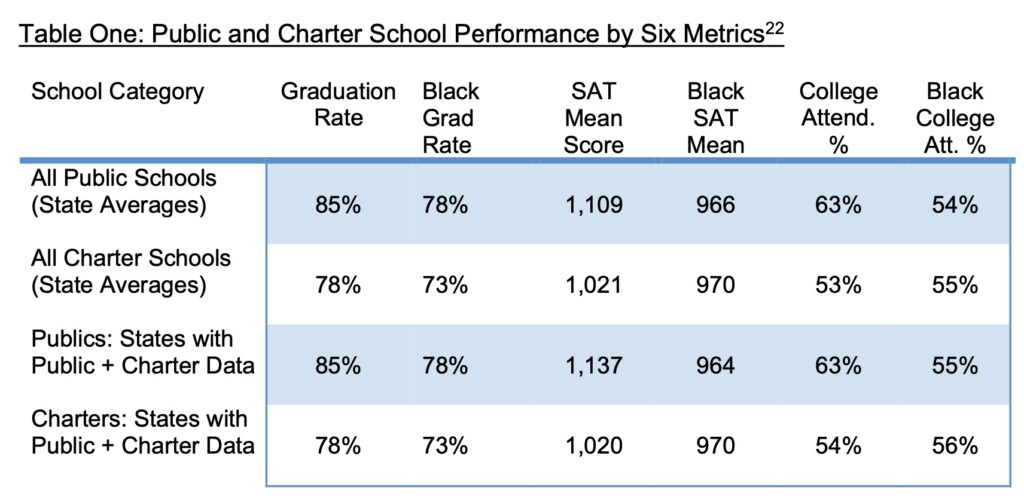
.
As previous scholars have noted (see Cohodes 2018), public schools and charter schools objectively seemed to perform at a very similar level during our ‘first stage’ analysis, with public schools having the advantage per some metrics. However, as is so often true in social science, these relationships are altered substantially when adjustments are made for the very different populations of the two academic eco-systems. As Sowell (2020: 2-3) points out early on: “Nationwide, white students plus Asian students are a majority of the students in the traditional public schools, while black students plus Hispanic students are a majority of the students in charter schools.” Further, charter schools are often located in “low-income minority communities (2020: 2).” We very much found that adjustment for these obvious population differences was essential, and that this adjustment substantially impacted empirical analysis of charter performance.
{{Table Two Appears as Appendix A}}
In terms of overall student success metrics, public schools frankly at first seemed to outpace charters, and to do so by a solid (if hardly enormous) margin per new 2019 data. Across the 51 state public school networks to report graduation rates, the average graduation rate was 85.25%. 23 In contrast, the average state-by-state graduation rate for charter students, across the 34 states with sufficient charter school data available for analysis, was 77.62%. 24 The average reported SAT score across the state public school systems was 1,109, while the average SAT score across the charter networks was 1,021. Finally, the state-by-state average percentage of public school graduates who went on to attend a college or university was 62.88% while the state-by-state average percentage of charter school graduates who went on to attend a college or university was 52.53%. At first glance, both varieties of school seem to do fairly well at educating students – but are we witnessing a clear win for traditional red-brick publics?

Not quite. As has been previously noted, the student body populations of public schools and charter schools are very different. While, as several authors cited so far predicted, white and Asian students still made up a roughly 60% majority of the traditional public school students in our data pool, the charter school student population was very heavily (~65%) Black and Latino. Simply switching the scope of analysis to BLACK students alone entirely changes most ratios of relative performance between public and charter school networks, and in fact reverses some relationships. For Blacks alone, high school graduation rates by state averaged 78% for public school students and 73% for charter kids – still a slight advantage for publics. However, the average state SAT score for charter school Black enrollees was a 970, as versus a 966 by-state average for Black students enrolled in public schools. The charter school college attendance rate for Blacks alone was also very slightly higher, at roughly 55% as versus 54.14% for public school Black students.
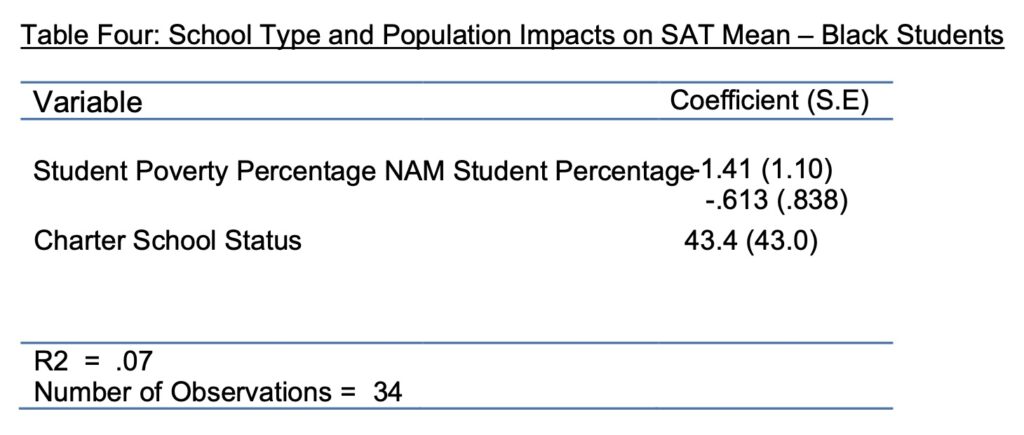
Since data on student outcomes was not available on a state-by-state basis for all charter school populations, it might be objected that comparing some or even most charter networks with essentially all state systems constitutes a case of comparing apples to oranges. A simple solution, at this stage of analysis, is to compare data across only those states for which both public and charter school figures were readily available. When this analysis was conducted, the relevant performance metrics changed very little.
For states reporting both blocs of data, the average public school graduation rate across all students was 85%, while the average charter graduation rate was 78%. The average public school graduation rate specifically for Black students was 78%, as versus an average charter graduation rate of 73% for Black students. The state-by-state average SAT for all test-takers was 1,138 for public school students overall, as versus 1,020 for charter school students overall. However, charter school Black students again beat public school Blacks on the SAT, 970 to 964. College attendance rates for all groups were virtually identical to those given above. Again, the overall public school population out-performs the overall charter school population, but that this relationship almost entirely vanishes when a single adjustment for race is made.
Race, Class, School Type, and Beyond
Even noting, and specifically adjusting for, the different racial demographics of the student populations of public and charter systems does not tell full the story of public: charter differences. Black people are often stereotyped as poor (Helmrich 1983; Hacker 1992; Taylor et al 2019; Oluo 2020), and racial income gaps clearly do exist – thus this paper. However, according to a “pro-Black” but quantitatively sound web resource (www.blackdemographics.com), just 21% of Black households today earn under $15,000 annually and thus fall into the category “poverty/working poor.” In contrast, 25% can fairly be called working class (up to $35,000), a 40% plurality are working-middle or middle class ($35,000-100,000), 12% are upper middle class ($100-200,000), and 2.7% are fairly wealthy – a figure not too far below the equivalent rate for whites. Many or most Black students today come from “normal” families and attend fairly typical public or private schools (McWhorter 2000; Ogbu 2003; Jack 2020).
In contrast, a very large percentage of students at most charter schools come from lower- income or at-risk student populations targeted by the school. For example, per the Appendices for this paper, “almost half of Indiana’s 49 charter high schools in fact serve an adult population,” including many former criminal offenders. Wyoming’s primary charter high school is located on a high-poverty Native American reservation, the Wind River Indian Reserve. Unsurprisingly, the average state public school system in our sample contained 41.9% non-Asian minority (NAM) students and 43.5% lower-income students, while the average charter system contained 62.6% NAM students and 51.9% lower-income students, many of these latter poorer than the very large majority of their public school peers.
{{Table Five Appears as Appendix B}}
As Tables 3-4 illustrate, all charter school students performed on par with all public school students, and Black charter school students as a group out-performed Black public school students as a group, during a simple regression analysis in which we adjusted for the NAM percentage and lower-income student percentage within each system. At a more basic level of analysis, regions with demographically similar charter school and public school populations, such as Washington D.C. (76% charter graduation rate vs. 69% public graduation rate) and Virginia (98/84) not infrequently see charter students simply outpace public enrollees with no adjustments needed.
Further, unlike men, not all charter schools are created equal. Charter schools and charter school networks fall into several distinct categories: brick-and-mortar vs. online or hybrid, lottery vs. first-come-first-served, STEM-focused or college preparatory vs. experimental in curricular terms, high-risk serving vs. low-risk serving, and so forth. Past authors have noted that high-performing charters tend to be brick-and-mortar lottery schools which share a range of instructional characteristics, very importantly including “a no excuses curriculum (Cahodes 2018; Sowell 2020).” There seems to be little doubt many such charters out-perform virtually all publics, and substantially boost student learning outcomes. Cahodes and Sowell provide more than a handful of inspiring elementary examples, and the high performance of secondary schools like Success Academy has been noted above.
We strongly affirm this conclusion (“such charters…virtually all publics”). During this project, we broke out the sizable sub-set of charter schools classified as high-performing –
defined here as those schools which boasted an SAT mean over their state average for all students, an SAT mean over the state average for Black students, a graduation rate over 90%, or a Black student graduation rate over 90% – in the six states to fully report all of this data broken down by race, and analyzed them on the basis of school characteristics. Of the 169 schools in this data set, 162 (96.4%) were brick-and-mortar schools with an actual physical plant in place, despite the increasing popularity of online and hybrid education.
Ninety-eight of the 129 schools for which this data was accessible (76%) were lottery- admission institutions as vs. either open-admission schools or test-focused magnet schools – indicating that parental motivation matters for success but student background genuinely may not. Most notably, 98 of the 111 schools to provide data re this point (88.3%) boasted a traditional college preparatory or classical educational curriculum, or a STEM-focused curriculum. Interestingly, 23 of the top schools – fully 14% – specifically mentioned student or parental “responsibility” as a core operating principle on their website or in their materials, requiring (for example) volunteering on the campus outside of school hours.
Among these top charter schools, only an “unlucky 13” of 111 institutions (11.71%) operated using what we half-jokingly coded as a ‘Woke’ curriculum, with code words like “equity” used in school materials. Further, these 13 wide-awake charters posted an average SAT score of just 1,000 – dozens of points below those in other curricular categories and 162 points behind schools offering a staid classical education. Overall, our results strongly support the finding that brick-and-mortar lottery charter schools, providing a no-excuses classical or technical education, do well by students. A more in-depth review of the data reflecting this appears in Table Six.
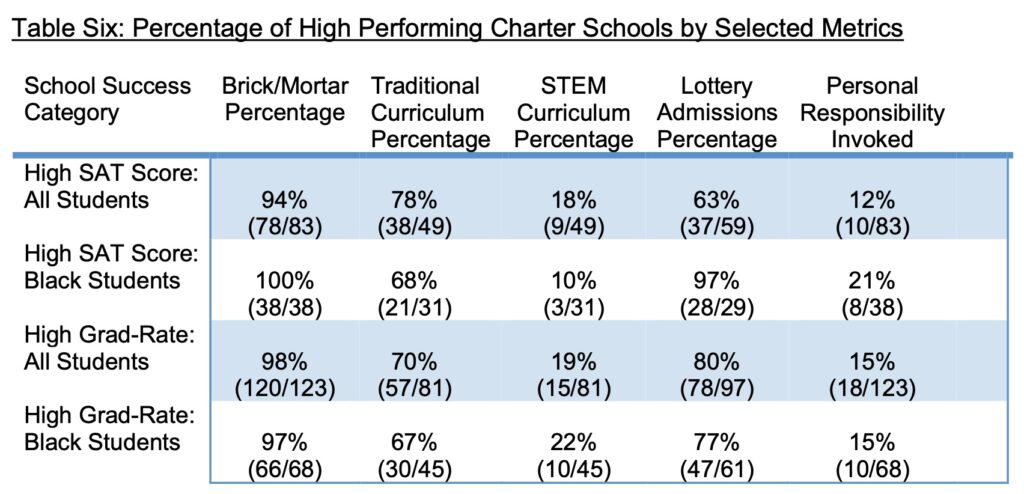
We encountered many such excellent charter schools during the course of this project. In Arizona, the BASIS charter network posted a graduation rate of 99.3%, failing to graduate exactly four students out of 554 across ten campuses – Ahwataukee, Chandler, Flagstaff, Mesa, Oro Valley, Peoria, Phoenix, Prescott, Scottsdale, and Tucson (North). 26 Great Hearts Academies did nearly as well, ‘dropping’ four students out of 461 across eight campuses. 27 Closer to home, 28 Northern Illinois Noble Schools network posted graduation rates of 95.2% (159/167) for the Noble Campus school, 94.8% (269/284) for Chicago Bulls Prep, 94.2% for UIC College Prep (220/234), and 92% for Muchin College Prep (224/243) – and saw only one of 16 sizable campuses fall below an 85% graduation rate. All of these schools largely fit the description of
successful charter schools provided above and in previous literature, although Great Hearts does offer some classes online. 29
The Potential Effect of Real Education on Black Incomes
There is little doubt that, were a re-vamped U.S. educational system to produce the educational gains among Black Americans that charter networks with ‘winning characteristics’ currently produce among all students – or even those that charter schools overall currently produce among low-income minority students – this would have a practical impact on Black incomes. As already noted, the current income gap between an American high school graduate and a citizen with just one four-year college degree is almost $30,000.
And, importantly, it is also true that a graduate of Yale is unlikely to make the same amount of money post-baccalaureate as a graduate of the University of Phoenix, or indeed of a perfectly solid brick-and-mortar institution like Western Illinois University. A comprehensive recent report put out by PayScale ranks early-career earnings after the BA/BS from $97,700 at 1st-place Harvey Mudd – and not far beyond that at MIT ($93,700), Stanford ($87,100) and Navy ($83,700) – all the way down to $39,800 at Nazarene Bible College and $36,800 at Johnson University. 30 Such earnings-by-campus track very closely with the average SAT score of each institution, which currently ranges from 1,500+ at a suite of top universities like “Harvard, Stanford, Cal-Tech, MIT, and Princeton” down to 1100-1200 at flagship Southern state universities like “Ole Miss” and the University of Missouri and below 1100 at quality non- flagships like Arkansas State, Illinois State, and the ‘directional’ campuses of the University of Colorado system. 31 & 32
While any analysis of this kind is purely hypothetical, plain logic implies that raising the state-by-state SAT average for Black students from (say) 970 to a 1070 – a reasonable goal well below the 1268 earned on average by Success Academy seniors or the 1162 earned by students in our “top charters” focused on classical education, but more than double the roughly 50-point SAT boost observed for all Black charter students during regressions – would boost their later incomes, increasing projected post-college earnings from the $40-45,000 available to graduates of non-selective institutions up to the roughly $65,000 available to graduates of Illinois State. 33 A jump to the Success Academy mean would move the same absolutely average Black student from a hypothetical $40-45,000 annual starting salary to the $76,000 earned by graduates of Syracuse 34 or the University of Colorado. 35 Being better educated, and thus testing better on the major aptitude exams, correlates with earning more money.
The performance of successful charter schools empirically illustrates how this much- needed educational improvement can take place. In one sentence: don’t be Baltimore. The two great, twinned problems facing the educators of many Black students – and, I suspect, of poor white students and recent Latino immigrants as well – are student apathy and misbehavior (Fordham and Ogbu 1986; McWhorter 2000; Ogbu 2003; Weissberg 2010; Ma 2011) and poor performances on the part of unmotivated school faculty and administrators (Gross 1999; Sowell 2003; Thernstrom and Thernstrom 2003; Sowell 2020). High-performing schools must and do become schools which avoid both pitfalls: teachers are often hired without regard to debatably useful education degrees, effective methods such as phonics replace trendy ones like “whole language” as the focus of curricula, 36 and violations of discipline are not permitted.
Most notably, students work, putting in long and focused hours of skill-training in the classroom. Describing the shared traits of a group of very successful Black institutions, Sowell sums these up as: “(In) successful schools for low-income minority students…emphasis is on work (2005: 220).” He then goes on to provide concrete examples of what this means. Within minority-serving schools in the highly successful Knowledge Is Power Program (KIPP) network, “students spend 67 percent more time in the classroom than the average public school student (2005: 219).” Even the personal time of ‘KIPPSTERS,’ when they are inside a school building, is occupied with learning: “Each morning, students receive a worksheet of math, logic, and word problems for them to solve in the free minutes (219).”
In these schools and similar ones, intense focus from the adults in the building on helping students learn is not merely expected but demanded. Chicago’s Earhart School, for example, devotes an hour and a half every morning specifically to phonics-based reading and word recognition exercises (2005: 219). During this reading period, “all physical education, music, art, and library” classes and activities stop, and “the entire support staff” for the school helps kids read (219). Schools of this kind are not magical outliers: the Heritage Foundation recently studied at least 21 public and charter examples of the genre for its “No Excuses” program, all of which scored above the 65th percentile on national achievement tests despite having 75+% lower-income student bodies (220). Sowell sums up the secret of their success, again, as: “The biggest secret is that there are no secrets, unless work is a secret (220).”
The newer and better schools to emerge down the pike need not be charters. As we observed in this paper, charters overall out-performed publics only for Black enrollees, and only against some variables. However, most of these top schools to come probably will be charter schools. Traditional American public schools are, to a rather remarkable extent, wired into a single model of education. Teachers with non-subject-specific education degrees, the utility of which has frankly often been questioned (see Kaminer 1991, 2001), teach according to pre-set curricula often determined at the state level. These teachers are members of powerful unions, which make it very difficult to reward innovative new pedagogies and even to punish incompetent or un-acceptably ideological teachers (Stern 1997; Gross 1999; Rhee 2013; Rufo 2021).
In contrast, charter schools can be created by any qualified private group; they often exist specifically for the purpose of educational innovation and the try-out of new ideas. While not all of these ideas succeed, many do – and there is little doubt that the boosts in student performance provided by innovative networks like Success Academy, KIPP, and BASIS have measurable positive impacts on “hard” dependent variables like college attendance and income later in life. Any expansion in the number of such successful institutions, and of similar ones, would by definition expand the universe of those receiving such benefits – potentially helping to move an entire community forward.
That, I suppose, is a trip we’d all like to “charter.”
. . .
. . .
Digging in the Texts: a Nearly Full List of Sources 37
Aurora, Rav. 2022. “Minority Privilege Now More Common Amid the Growing ‘War on Whiteness.’” The New York Post. 8 January.
Bertrand, Marianne, and Sendhil Mullainathan. 2004. “Are Emily and Greg More Employable Than Lakisha and Jamal?” American Economic Review. 94: 991-1013.
Cahodes, Sarah. 2018. “Charter Schools and the Achievement Gap.”
Retrieved September 28, 2021 from: https://futureofchildren.princeton.edu/sites/futureofchildren/files/resource-links/charter_schools_compiled.pdf.
Darolia, Rajeev, and Cory Koedel. 2016. “An Updated Analysis of Race and Gender Effects on Employer Interest in Job Applicants.” University of Missouri Public Policy Briefs. Report 04B-2016.
Fordham, Signithia, and John Ogbu. 1986. “Black Students’ School Success: Coping with the “Burden of Acting White.” The Urban Review. 18: 176-206.
Gaddis, Michael. 2017. “How Black Are Lakisha and Jamal? Racial Perceptions from Names Used in Correspondence Audit Studies.” Sociological Science. 4: 469-489.
Gross, Martin L. 1999. The Conspiracy of Ignorance. New York: Harper Collins.
Hacker, Andrew. 1992. Two Nations: Separate, Hostile, Unequal. New York: Scribner.
Hacker, Andrew. 1995. Two Nations: Separate, Hostile, Unequal (Extended). New York: Scribner.
Harris, Cheryl. 1993. “Whiteness as Property.” Harvard Law Review. 106: 1707-1791. Helmreich, William. 1983. The Things They Say Behind Your Back. New York: Routledge. Jack, Anthony Abraham. 2019. The Privileged Poor. Boston: Harvard University Press. Kendi, Ibram X.38 2019. How to Be an Anti-Racist. New York: One World Books.
Kendi, Ibram X. 2020. Stamped: Racism, Anti-Racism, and You. New York: Little, Brown, and Company.
Kramer, Rita. 1991. Ed School Follies: the Miseducation of America’s Teachers. New York: Free Press.
Ma, Ying. 2011. Chinese Girl in the Ghetto. Multiple Locations: CreateSpace Publishing. McWhorter, John H. 2000. Losing the Race: Self-Sabotage in Black America. New York:
The Free Press.
Ogbu, John. 2003. Black American Students in an Affluent Suburb. New York: Routledge.
Oluo, Ijeoma. 2020. Mediocre: the Dangerous Legacy of White Male America. New York: Seal Press.
O’Neill, June. 1990. “The Role of Human Capital in Earnings Differences between Black and White Men.” Journal of Economic Perspectives. 4: 25-45.
O’Neill, June, and Dave O’Neill. 2006. “What Do Wage Differentials Tell Us about Labor Market Discrimination?” Research in Labor Economics. 24: 293-357.
Pager, Devah. 2003. “The Mark of a Criminal Record.” American Journal of Sociology. 108: 937-975.
Papst, Chris. 2021. “Baltimore: 41% of High School Students Earn Below 1.0 GPA.”
Retrieved September 24, 2021 from:https://www.realcleareducation.com/2021/07/16/baltimore_41_of_high_school_students_earn_below_10_gpa_50154.html.
Papst, Chris. 2021. “City Student Passes Three Classes in Four Years, Ranks near Top Half of Class with .13 GPA.” Retrieved September 27, 2021 from: https://foxbaltimore.com/news/project-baltimore/city-student-passes-3-classes-in-four- years-ranks-near-top-half-of-class-with-013-gpa.
Payscale Staff Team. 2021. “Payscale’s Comprehensive 2021-22 College Salary Report.” Retrieved September 12, 2021 from: https://www.payscale.com/college-salary-report.
Prager, Dennis. 2016. “The Fallacy of ‘White Privilege.’” National Review. 16 February. Rameswaram, Sean, and Lauren Katz. 2020. “Professor: Ibram X. Kendi on Why It’s Not
Enough to Admit When You’re Being Racist.” Vox. 1 June.
Rhee, Michelle. 2013. Radical: Fighting to Put Students First. New York: Harper Paperback.
Reilly, Wilfred. 2020. Taboo: Ten Facts You Can’t Talk About. Washington, DC: Regnery.
Reilly, Wilfred. 2021. “Testing the Tests for Racism.” Academic Questions. 34: 17-27.
Rufo, Chris. 2021. “Going All In: the NEA Pledges to Bring Critical Race Theory to a Public School Near You.” City Journal. 15 July.
Sander, Richard, and Stuart Taylor Jr. 2012. Mismatch. New York: Basic Books.
Sowell, Thomas. 1984. Civil Rights: Rhetoric or Reality? New York: William Morrow.
Sowell, Thomas. 1995. The Vision of the Anointed. New York: Basic Books.
Sowell, Thomas. 2005. Black Rednecks and White Liberals. San Francisco: Encounter Books.
Sowell, Thomas. 2020. Charter Schools and Their Enemies. New York: Basic Books.
Stern, Sol. 1997. “How Teachers’ Unions Handcuff Schools.” City Journal. Spring Issue.
Taylor, Evi, Patricia Guy-Walls, Patricia Wilkerson, and Rejoice Addade. 2019. “The Historical Perspectives of Stereotypes on African-American Males.” Journal of Human Rights and Social Work. 4: 213-225.
Thernstrom, Abigail, and Stephen Thernstrom. 2003. No Excuses: Closing the Racial Gap in Learning. New York: Simon and Schuster.
Weissberg, Robert. 2010. Bad Students, Not Bad Schools. New Brunswick (N.J.): Transaction Publishers.
Williams, Walter. 2015. “The True Black Tragedy.” Retrieved September 26, 2021 from: https://www.creators.com/read/walter-williams/05/15/the-true-black-tragedy.
Xu, Kenny. 2021. An Inconvenient Minority. New York: Diversion Books.
. . .
. . .
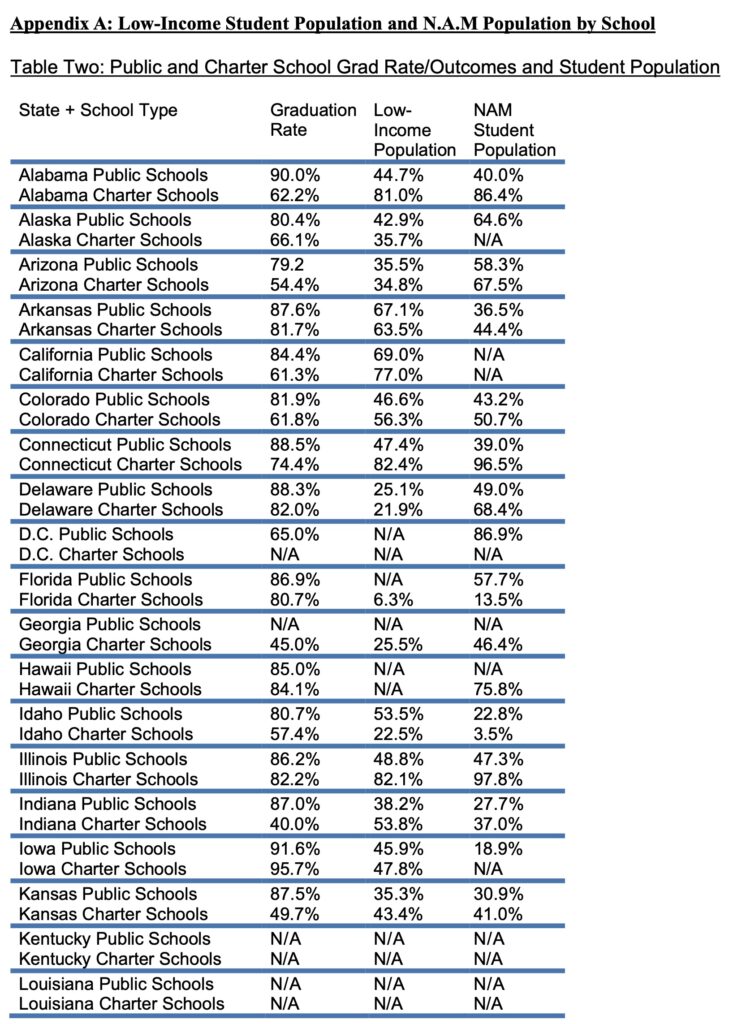
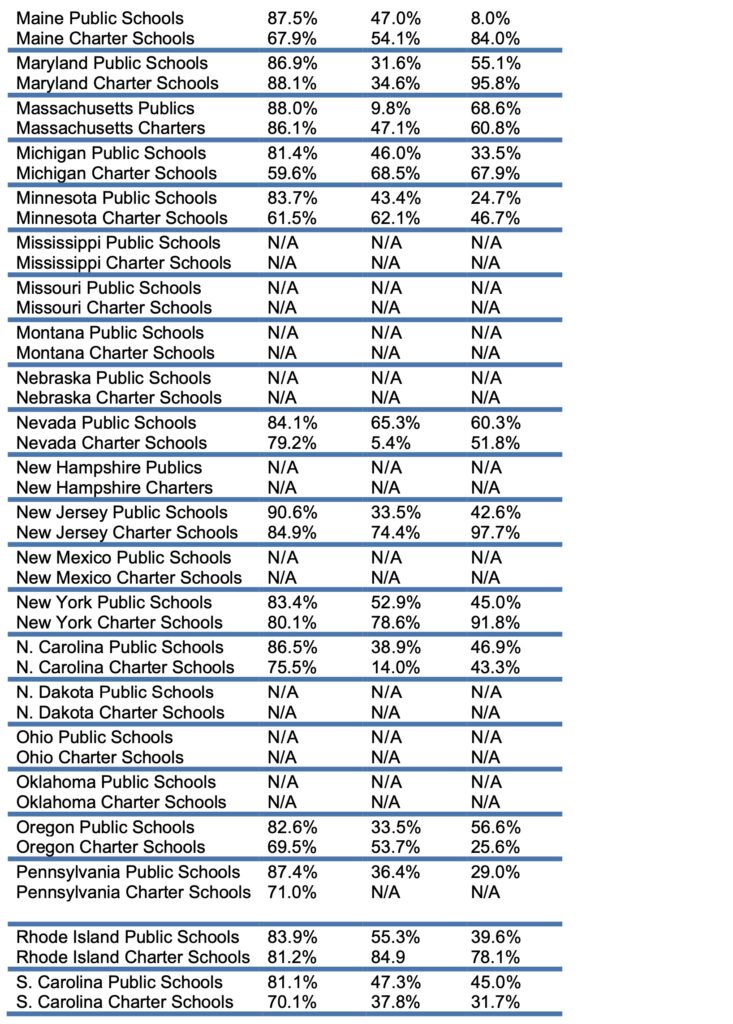
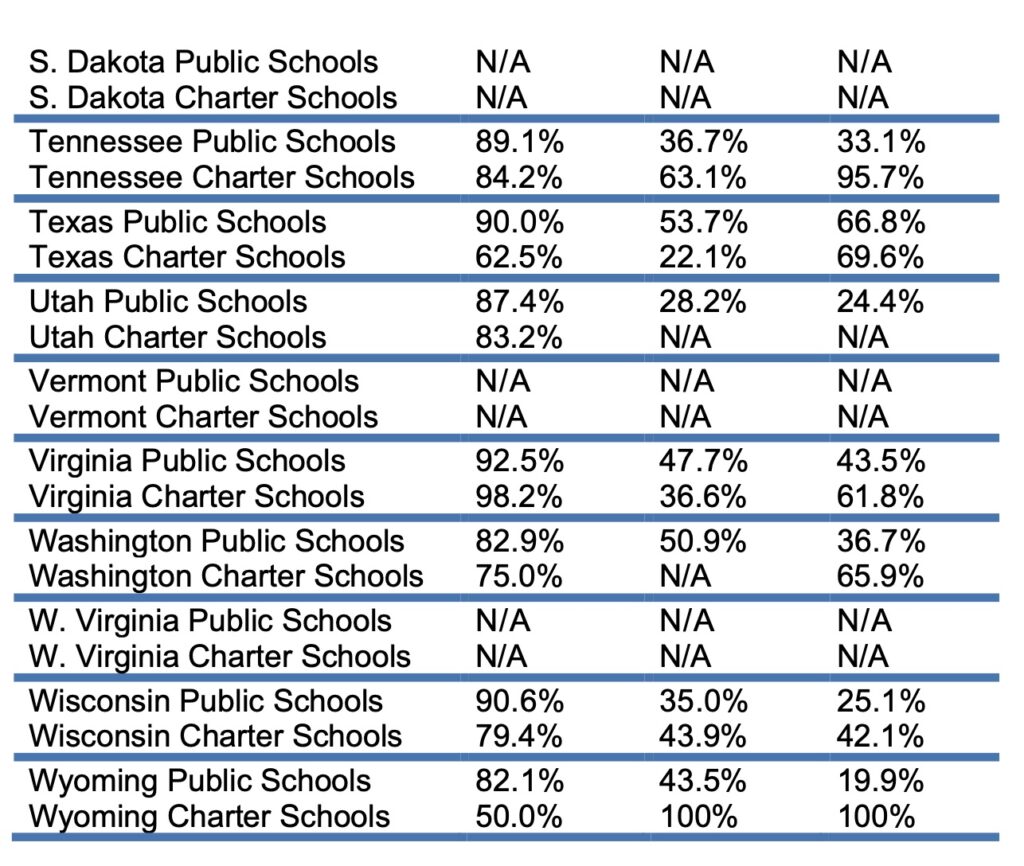
. . .
. . .
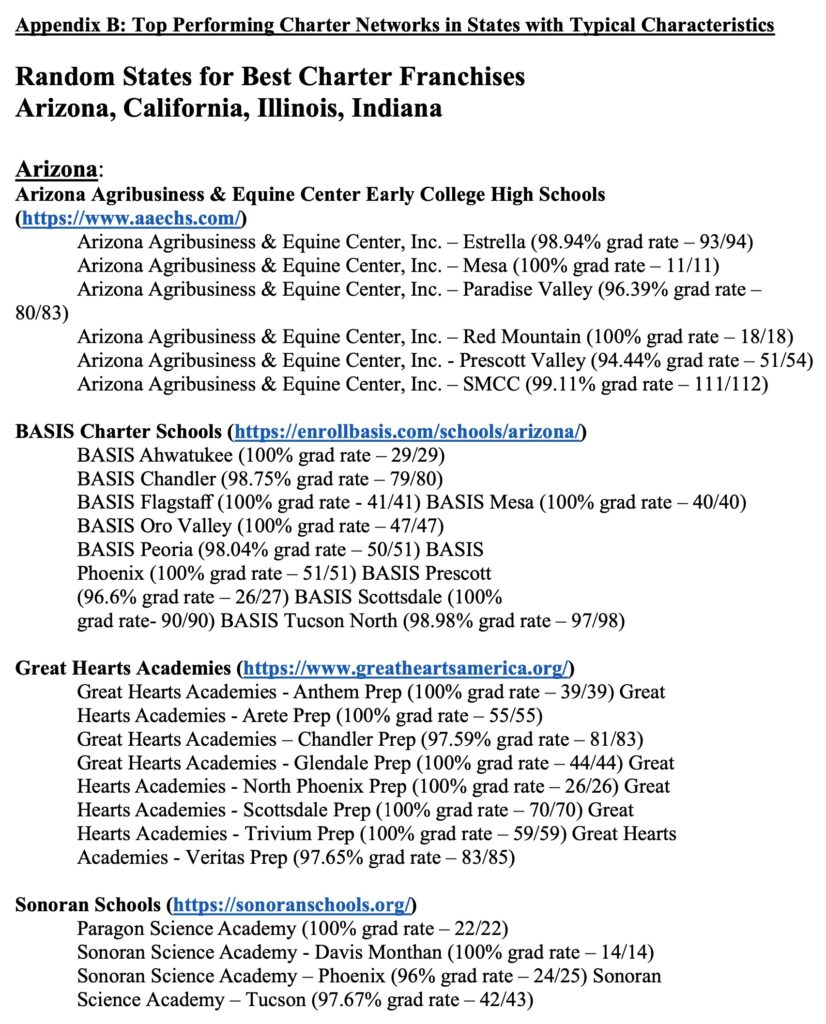
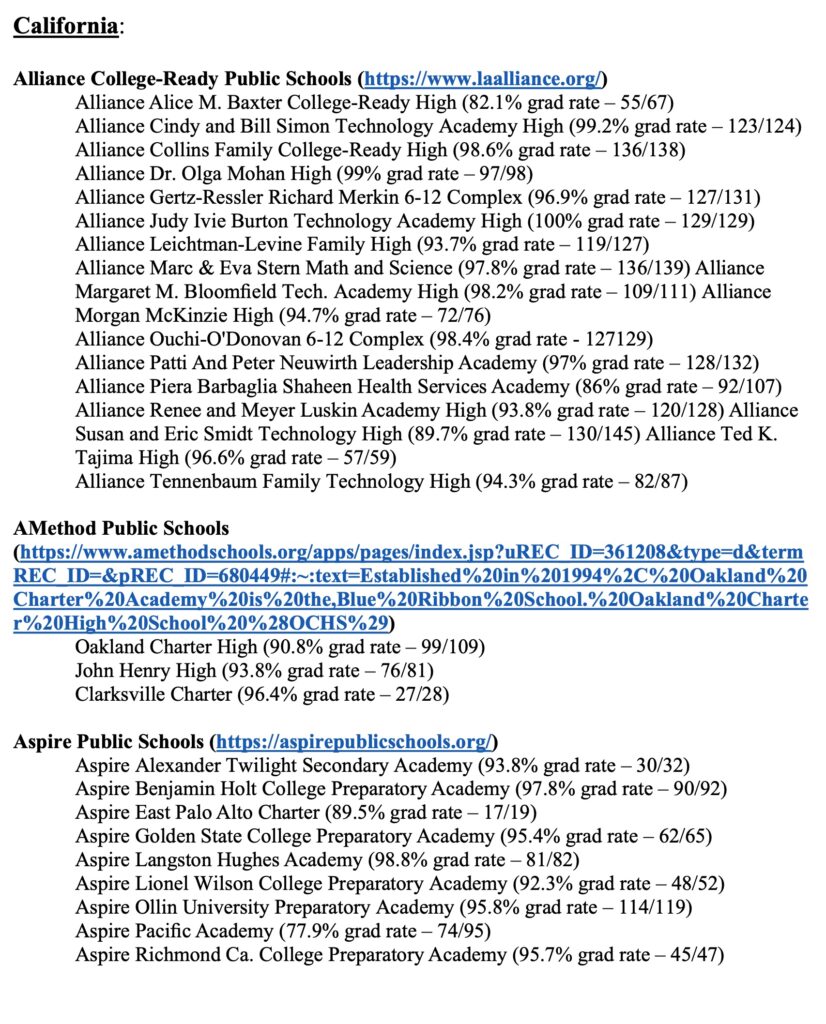
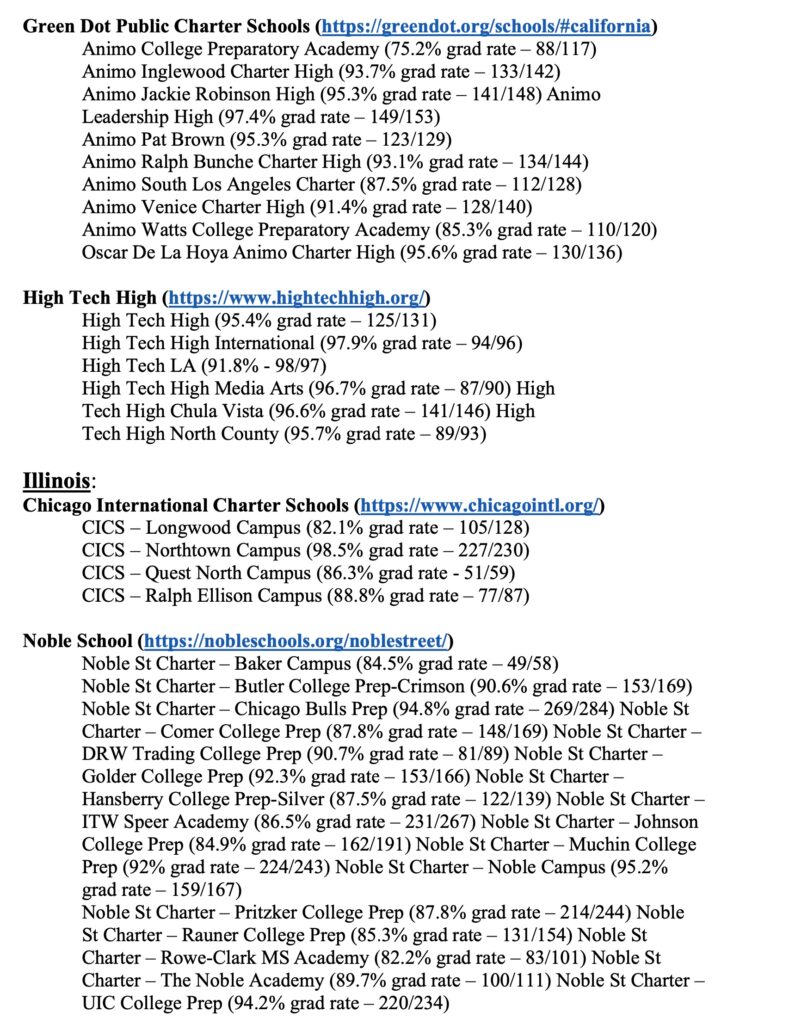
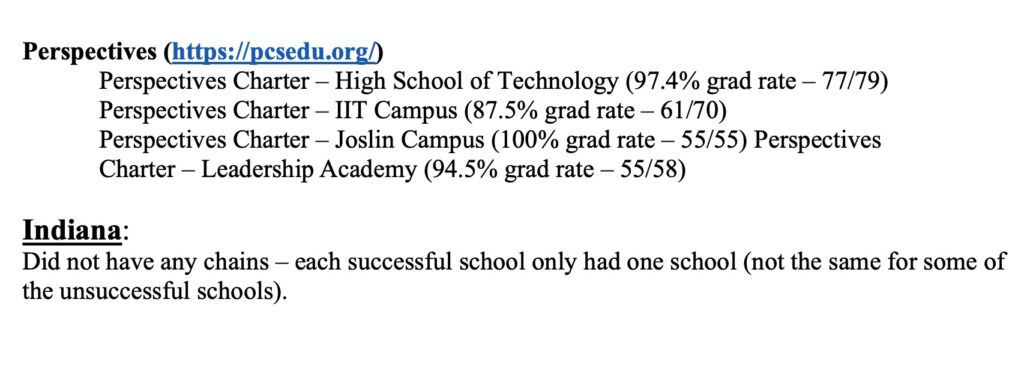
ENDNOTES:
1 https://data.census.gov/cedsci/table?q=Table%20S0201%20&t=529%20- %20English%20%28015,%20022%29%3AAncestry&tid=ACSSPP1Y2019.S0201&hidePreview=true.
2 https://en.wikipedia.org/wiki/Personal_income_in_the_United_States.
3 https://data.census.gov/cedsci/table?tid=ACSSPP1Y2018.S0201&hidePreview=true.
4 See D’Souza (1995) or McWhorter (2005) for an extensive critique of this argument.
5 An obviously short-hand, but widely used and easily accessible version of this data is available here:https://en.wikipedia.org/wiki/List_of_ethnic_groups_in_the_United_States_by_household_income.
6 https://www.pewresearch.org/fact-tank/2019/07/30/most-common-age-among-us-racial-ethnic-groups/
7 https://www.dailymail.co.uk/news/article-9925561/The-secret-bias-hidden-mortgage-approval-algorithms.html.
8 https://www.nas.org/academic-questions/34/3/testing-the-tests-for-racism.
9 https://www.insidehighered.com/news/2017/09/27/scores-new-sat-show-large-gaps-race-and-ethnicity.
10 Books like Booker T. Washington’s Up from Slavery and E. Franklin Frazier’s The Black Bourgeoisie obviously provided dramatic counter-points to this trend in the past.
11 https://www.creators.com/read/walter-williams/05/15/the-true-black-tragedy
12 https://www.nationalreview.com/2016/02/white-privilege-myth-reality/
13 A short list of the major papers documenting these can be found here: https://fathers.com/statistics-and- research/the-consequences-of-fatherlessness/
14 https://www.bls.gov/news.release/pdf/wkyeng.pdf
15 https://www.youneedaschoolhouse.com/rosenwald-schools
16 https://nypost.com/2021/12/11/asian-womens-success-disproves-of-white-male-supremacy/
17 https://foxbaltimore.com/news/project-baltimore/city-student-passes-3-classes-in-four-years-ranks-near-top-half- of-class-with-013-gpa
18 https://www.realcleareducation.com/2021/07/16/baltimore_41_of_high_school_students_earn_ below_10_gpa_5015 4.html.
19 https://www.baltimorecityschools.org/board-commissioners
20 https://nypost.com/2020/05/01/entire-success-academy-senior-class-accepted-to-college/
21 https://www.amazon.com/Charter-Schools-Enemies-Thomas-Sowell/dp/1541675134
22 In all models appearing in this chapter, significance is measured using “stars” thus: one star indicates significance at the .05 level, two stars indicate significance at the .01 level, and three stars indicate significance at the .001 level. What is being tested is whether or not between-group differences in the increased number of mean answers for my identity questions between Survey B and Survey C – which exactly indicate the level of willingness to change identity for each group – are statistically significant. The data in Figure One was generated using Question Three on List Experiment surveys B and C.
23 Of course, some “games” are possible with this data. For example, graduation rate data can be coded to represent the graduation rate in Year X for students entering their senior cohort that year. Thus, presumably, a well-known miscreant who dropped out at the end of junior year would not be included within the numerator or the denominator used to construct the figures we analyze. While this is largely a personal opinion based upon Reilly’s experiences during conversations for this paper, reviews of relevant news stories, and the like, we “get the feeling” that charter schools are generally more likely to report student data ‘straight’ than are many of certainly the larger public school systems.
24 All rates and scores provided in this paragraph represent a mean average as calculated across all state and charter systems with available data; calculation was done in this manner to minimize outlier effects (i.e., what might a low public school graduation rate for California mean for all P.S. graduation rate data?). The results of other calculation methodologies are available from the authors upon request, as is the underlying public and charter data itself.
25 For the “star-gazers:” in all models in this paper, one asterisk/star indicates significance at the .05 level, two stars indicate significance at the .01 level, and three stars indicate significance at the .001 level.
26 https://www.basised.com/
27 https://www.greatheartsamerica.org/
28 https://nobleschools.org/
29 Two quick notes here: first, most of the schools just named – including all of the BASIS academies – offer K-12 education. So, not all of their students are included within the “high school graduation rate” numbers for charter school students on an annual basis. Second, it might be claimed that high attrition rates at some point – for example, (intentional?) failure to retain students before the start of their senior year or even high school career – contributes to the SAT averages and graduation rates posted by successful charter schools. However, this same point can be made against publics serving a student body population at all similar to that served by charter schools. Per frankly reported data from the state of Texas, the freshman-to-senior non-retention rate is currently at least 20%, has ranged as high as 33% during the past several decades, and is TWICE as high for NAM students as for white ones: https:// files.eric.ed.gov/fulltext/ED609722.pdf.
30 https://www.payscale.com/college-salary-report/bachelors
31 https://www.testgeek.com/sat-scores-guide.html
32 https://www.stateuniversity.com/rank/sat_75pctl_rank.html
33 https://www.payscale.com/research/US/School=Illinois_State_University/Salary.
34 https://www.payscale.com/research/US/School=Syracuse_University/Salary
35 https://www.payscale.com/research/US/School=University_of_Colorado_-_Boulder_(UCB)/Salary
36 Discussions of this particular controversy within several of the works just cited, most notably Gross (1999) and Sowell (2003) are worth reading-through in depth.
37 Citations in this section reflect all parenthesis-referenced scholarly works within the paper, and also all Internet- sourced contemporary articles with a named author.
38 Dr. Kendi’s real name is the less exotic “Henry/Hank Rodgers.” Google this.